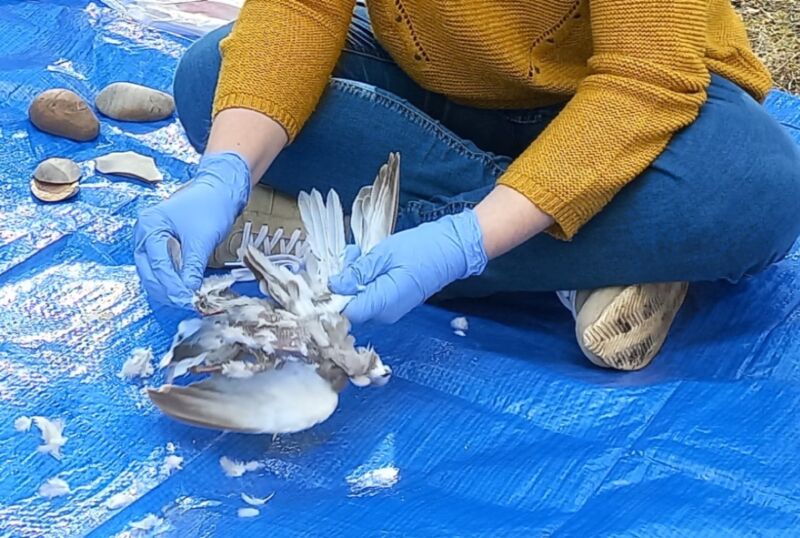
Mariana Navais
Archaeologists seeking to learn more about how Neanderthals prepared and cooked their food conducted a series of experiments on small birds using flint flakes to butcher them. They found that the flint flakes were surprisingly effective at butchering birds, according to their studies. New paper The study was published in the journal Frontiers in Environmental Archaeology. The researchers also concluded that roasting birds damages the bones to such an extent that they are unlikely to be preserved in the archaeological record.
According to the authors, Neanderthals were able to thrive for more than 200,000 years across a wide range of geographic regions, so it’s natural for archaeologists to be interested in how they supported themselves. There has been research into their killing and hunting of large game. Neanderthals were skilled hunters known to have killed bears and other carnivores. A pair of Middle Paleolithic lion bones found in eastern Iberia with cut marks suggests that the lion had been butchered, while another lion bone found in southwestern France from the same period had cut marks indicating that it had been skinned.
As we reported last year, researchers have found evidence of what may be the oldest known example of a lion hunt to date, based on a careful forensic analysis of a cave lion skeleton that showed evidence of a wooden spear wound from about 48,000 years ago.
The team tested their hypothesis by reconstructing data from the impact of the wooden-tipped spear on the rib, matching the direction, angle of impact, and depth of penetration. Judging from these aspects, the spear appears to have passed through the left side of the cave lion’s abdomen and passed through vital organs before striking the right side of the rib. The same study also found cave lion claw bones that showed evidence of having been skinned about 190,000 years ago.
But the small birds have received little attention. “Birds provide a supplementary food resource that may have played a key role in Neanderthal adaptation and survival,” study co-author Mariana Navas, of the Catalan Institute of Paleobiology and Social Evolution in Spain, and her colleagues wrote. So they designed an experimental study that mimicked early human cooking and butchering practices to provide a baseline, and to compile a database of telltale signs that could help archaeologists better analyze artifacts by comparing the signs on them to the database.
Birds roasted on an open fire
Nabaes and others collected frozen bird specimens that died naturally from a wildlife reserve in Portugal, and selected species that were taxonomically representative of those that Neanderthals were likely to have hunted on the Iberian Peninsula: the carrion crow, the wood pigeon, and the Eurasian collared dove. Feathers were removed from all five specimens.
Two of the bones were butchered without cooking, using replicas of flint flakes (made by the students) where necessary; the techniques used were derived from archaeological evidence and ethnographic data. The scientists then cleaned and dried the bones, and examined them under a microscope for distinctive cut marks, fractures, and burns. They also analyzed the flint flakes for signs of wear and tear, finding small, half-moon-shaped scars on the edges.
-
Effects of use on chips used in butchering.
Marina Igreja
-
Bones recovered from birds.
Mariana Navais
“Using flint chips in slaughter requires a great deal of precision and effort, which we had not fully appreciated before this experiment,” Nabis said“The flakes were sharper than we initially thought, requiring careful handling to make precise cuts without injuring our fingers. These hands-on experiments underscored the practical challenges of food processing and cooking for Neanderthals, providing a tangible link to their daily lives and survival strategies.”
The other three birds were roasted whole (not butchered) over hot coals at 500 degrees Celsius: first on their bellies for four minutes, then flipped and grilled for another three minutes. The team was careful to maintain a constant temperature and monitor the cooking time so as not to overcook the meat. “Perhaps because we de-feathered the birds before cooking, the roasting process was much faster than we expected,” says Dr. Nabis said“In fact, we spent more time preparing the charcoal than actually cooking, which took less than ten minutes.”
The team also analyzed the cooked bird bones. In the former case, the bones were much more fragile—some were broken—and almost all had black or brown burns, as well as black spots inside the interior cavities of some bones. “Because burned bird bones are prone to breakage and loss, roasting activities may have gone undetected at archaeological sites,” the authors wrote. “Such observations suggest that cooking methods significantly influence the preservation of skeletal remains in archaeological contexts, potentially affecting the archaeological visibility of certain culinary practices.”
Nabasi et al. emphasize that this is just a pilot study with a very small sample size and limited species; the types of birds consumed by Neanderthals may have been more diverse. Despite their careful control of the experimental conditions, it is simply not possible to replicate Neanderthal methods, real-world conditions, and broader cultural contexts specifically. They call for further research and expansion of the experiments to include more bird species and different cooking methods.
Frontiers in Environmental Archaeology, 2024. DOI: 10.3389/fear.2024.1411853 (About DOIs).

“Beer aficionado. Gamer. Alcohol fanatic. Evil food trailblazer. Avid bacon maven.”
